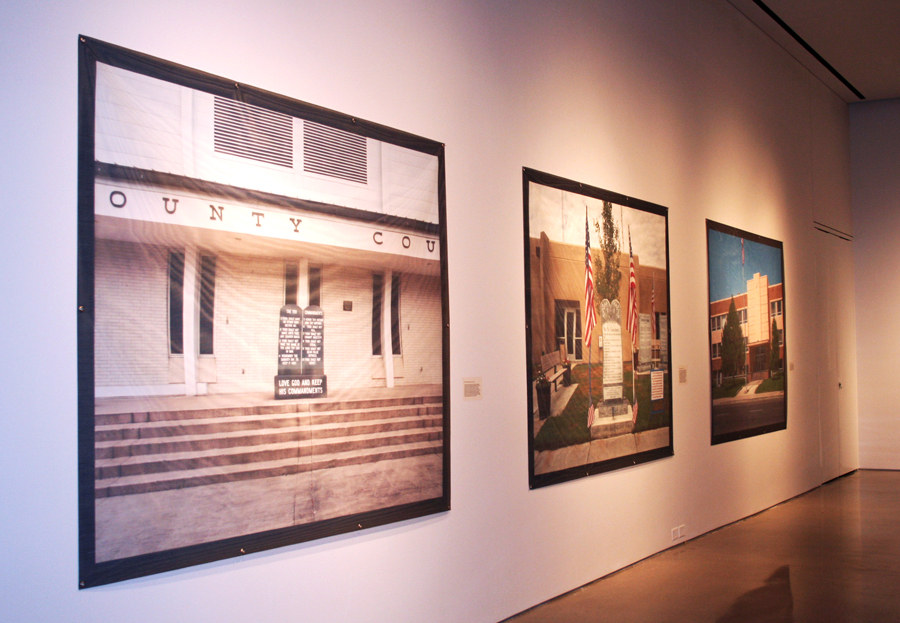New York photography duo Andrea Robbins and Max Becher began photographing and researching monuments of the Ten Commandments when living in the southern United States.
“We started photographing and researching the subject and were surprised by how differently the monuments are treated by the courts, how widespread they are, and how they seemed to be part of three historic waves,” Robbins told the Manitoban.
The first wave came in the 1930s, followed by monuments provided by the Fraternal Order of Eagles in the 1950s, and the most recent inspired by Judge Roy Moore of Alabama in 2003.
Located outside courthouses, public schools, parks, and county seats, these religious monuments have been surrounded by controversy.
But more interesting than the controversy is the manner in which the designers have maneuvered around laws in places with strict stipulations on the public depiction of religion.
“Some groups have tried to design Ten Commandment monuments that incorporate different symbols or they place the display within a group of historic monuments in order to assert that its importance is as one of many influences to American law and not a religious icon.”
These are the same groups that outwardly argue that the Christian cross in public places is in fact not a religious symbol, but rather a lowercase t.
Ironically, these manipulations do not necessarily need to be in place.
“Like many people, we were raised to believe that the U.S. Constitution laid out a separation of church and state, and this is not exactly the case. The Establishment Clause of the First Amendment does not call for a separation, but is a precaution against a government endorsement of one religion over another, or a preference for religion over the belief in no religion.”
The Establishment Clause of the First Amendment states, “Congress shall make no law respecting an establishment of religion or prohibiting the free exercise thereof.”
This clause has proved unclear.
The Supreme Court has allowed religious appeals to open legislative assemblies, private religious school textbook funding by the government, and schedule arrangements by school districts to accommodate extra-curricular religious education – and disallowed certain outwardly religious monuments on courthouse land.
This lack of clarity has resulted in differing levels of legal disputation and citizen resistance to acceptance of the monuments into the community.
“It takes about 10 minutes of photographing—sometimes more or less—before someone shows up. In small towns, we like to make our visits short and we make return visits in order to photograph again in the best light which depends on the direction the monument faces and its surroundings.”
Robbins and Becher’s work have captured the interest of Shep Steiner, U of M assistant professor in the school of art.
“I received a grant from the University Research Grants Program to visit these artists in New York, and thought the money better spent if I brought them here to give a lecture, meet with students. The school of art agreed to help pay for an exhibition, so that’s how things developed,” explained Steiner.
Following the Ten Commandments will mark the first time Robbin and Becher’s work has been brought to Canada – and it is fitting that it is in Winnipeg.
“Robbins and Becher’s project [ . . . ] has a local connection here in Winnipeg. The only Ten Commandment monument in Canada is in the formal garden in Assiniboine Park.”
The photography within the exhibit includes the landscapes in which the monuments are placed, to contextualize the controversy, a feature that is important to Robbins.
“We show them along with their unique surroundings – so sometimes the monument is front and centre and sometimes not. Finding the recurring shape in the photo is like a game and forms an initial level of engagement with the viewer in the gallery. We provide a text next to each image that is just a few words or quite long depending on the specific history.”
Following the Ten Commandments will be displayed at the School of Art Gallery until Feb. 20, 2015. The gallery is open from 9 a.m.-4 p.m. Monday-Friday, but will be closed from Dec. 23-Jan. 5.


